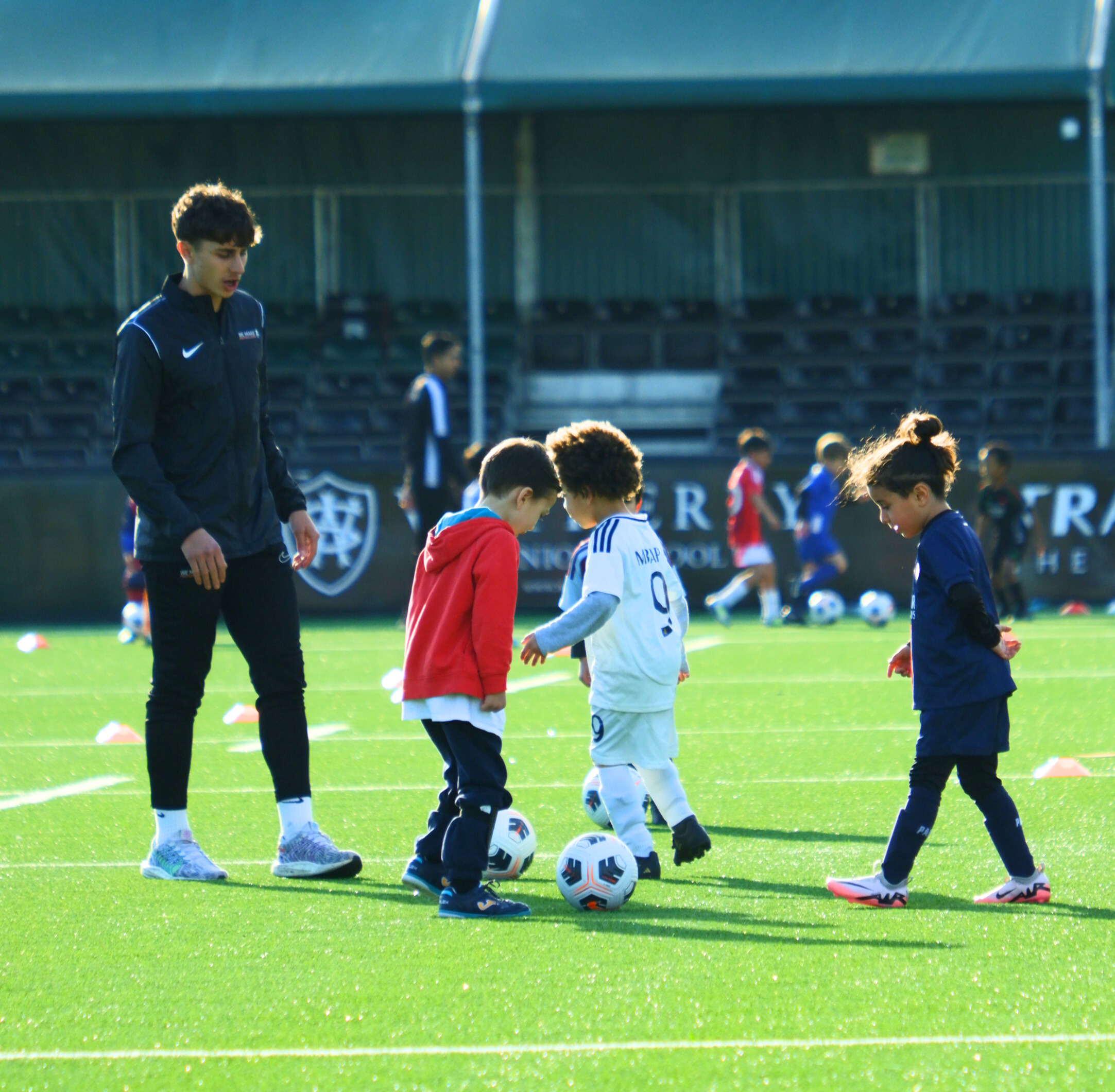When it comes to the importance of food and water in fuelling the body to deliver peak sporting performances, millions of words have been written. Even more important and yet nowhere near as widely covered is the power of breathing.
Think about it for a minute. Away from an athletic arena, a human can go weeks without food and days without fluids. But how long could we survive without oxygen? No more than a few minutes.
Breathing is the most important function for a human being. Understanding how to use it correctly in a sporting context can lead to huge improvements in performance – especially in children, for whom good habits developed at a young age can stick for life.
We Make Footballers and the power of breathing
We Make Footballers rely to a certain extent on the parents of our football players to make sure their children are prepared for training. Kids need to have taken on board enough water to avoid dehydration and the right foods to boost energy levels.
English football has become hugely aware of the importance of diet, ever since Arsene Wenger rocked up at Arsenal and banned his players from having ketchup. Concepts such as carb-loading are now commonplace. The precise levels of fluid needing to be drunk and exactly when prior to physical activity beginning are well-known.
What we want to do now is help parents improve the breathing techniques of their children. Not only will this help kids on the football pitch, but it can also make them healthier, happier and more attentive in school and at home. That is the true power of breathing.
Breathe through the nose, not through the mouth
In through the nose, out through the mouth. Noses are meant for breathing, mouths are meant for eating. Two phrases which everyone will have heard at some point in their life. And whilst the sayings are familiar, how many of us ever had the actual science behind it explained to us?
Breathing through the mouth initiates short, shallow breaths that supply oxygen to the upper part of the lungs but not much further. Breathing through the nose results in proper use of the diaphragm – the muscle designed to aid breathing – to pull oxygen down to the bottom of the lungs, completing filling them.
Clearly, the more oxygen you have entering the lungs, the better. But that is not all. Gravity means that more blood resides in the lower part of the lungs. Getting a greater volume of oxygen to the area where there is an increased amount of blood to distribute it around the body can lead to blood that is 10 to 15 percent more oxygenated.
This means that there more oxygen is supplied to muscles that need it to stay fuelled and avoid fatigue. More oxygen is also reaching the brain, which helps keep the mind clear to control the body with greater efficiency.
This has a significant impact on both physical and mental output during football, giving players greater endurance and increased energy levels. In the final 10 minutes of a football session, that can make all the difference.
Reasons to avoid breathing through the mouth
Unfortunately, a lot of the guidance that does exist on the internet surrounding breathing and exercise is full of incorrect information. One of the most common misconceptions is the idea that breathing through the mouth whilst taking part in physical activity is better for you because the mouth is bigger than the nostrils and can therefore suck in more air.
This is wrong for a couple of reasons. One is that the mouth and throat are full of a lot of dead space; that is room in which oxygen can be lost before it makes it to the lungs. Compare that to the nose, where the route to the lungs is far more compact and streamlined. Less oxygen is lost because the nose is more efficient at transporting it to where it needs to be.
There is also a tendency to over-breathe through the mouth, resulting in more carbon dioxide leaving the body. It is commonly assumed that carbon dioxide is simply a waste product of the breathing process, when it actually acts as a catalyst for oxygen to be released from red blood cells into muscles.
It is therefore beneficial to have some carbon dioxide in the system as it helps optimise oxygen delivery into areas it is needed. This can have a huge impact on speed, strength and endurance – three physical attributes that are important in football.
Busting the myth about hands on knees
Another myth surrounding breathing and sport is that hands on knees when trying to get oxygen into the body is bad.
Many coaches will berate players who bend over at the end of a particularly exhausting exercise. They believe either that hands behind head opens up the airwaves, or they think players bent over is a sign of tiredness or weakness to the opposition.
A 2019 study of recovery positions following heavy exercise found that athletes recovered more quickly with their hands on their knees, rather than in the hands behind head position that has almost become default.
There is a reason why most football players will instinctively go for hands on knees – it feels more natural. Much more important than the position taken when needing to catch a breath is the technique used, which again comes down to employing nasal breathing rather than gasping for air through the mouth.
Drills to improve breathing
Understanding the power of breathing is one thing. Changing habits to be able to breathe better and receive the boost in football performance that can bring is quite another. With this in mind, we have put together three simple drills which can be used to help children improve their breathing.
Breath holding
An exercise as simple as holding breath can help to improve the effectiveness of breathing and oxygen transfer in the body. By not breathing out, carbon dioxide levels rise. This increases the body’s tolerance to the gas.
The more carbon dioxide that the body becomes acquainted with handling, the more it will be capable of using in the transfer of oxygen from red blood cells to muscles.
Regular breath holding exercises – whereby a child does not breathe out until they feel the need to – can have a dramatic impact on performance by increasing the amount of oxygen the body is capable of passing into the muscles in any one hit.
7/11 breathing
When playing football or partaking in other types of physical activity, the body enters what is known as a sympathetic state. It cannot begin to recover until it relaxes into parasympathetic state, whereby it completely relaxes and the job of repairing and recuperating starts.
Breathing can help speed up the chance from sympathetic to parasympathetic state by regulating the heart and getting more oxygen into the body. The most effective way to do this is by carrying out a 7/11 breathing exercise as soon after football training has finished as possible.
There is nothing complicated about this particular drill. Seven seconds of inhaling oxygen followed by an 11 second exhale. Performing 7/11 for between three and five minutes after football training will not only improve long-term breathing, but speed up the recovery process to reduce fatigue and tiredness.
Diaphragmatic breathing
Every muscle in the body can be strengthened through use – the reason gyms exist - and the diaphragm is no difference. By training and improving the effectiveness of the diaphragm, nasal breathing becomes an efficient habit.
This is the way that nature intended us to breathe. Watch a baby breathe and you see its belly rise and fall because of the work being done by the diaphragm. By the time childhood is reached, bad habits tend to have taken over and chest breathing or breathing through the mouth is dominant.
The good news is that the body can be trained out of those bad habits using a diaphragmatic breathing drill. The exercise begins by lying on the floor with knees bent. The writing hand is placed beneath the navel and the other hand above the navel.
A deep breath through the nose fills the area below the navel with the air, which then moves into the rib cage and finally to fill the upper third of the lungs. Once the lungs have been completely swelled with oxygen, a deep breath expels the air and contracts the belly.
Diaphragmatic breathing not only strengthens the diaphragm to improve performance, but it also helps the body relax by reducing stress and tension. If it is practiced enough, deep breathing using the diaphragm becomes second nature.
The power of breathing away from football
Good breathing techniques extend beyond improving a child’s performance at We Make Footballers. They have far-reaching benefits in general life. Sleep quality is directly impacted by breathing – the better a child breathes, the higher quality rest they enjoy.
This manifests itself most clearly in snoring. Studies suggest that there is an 80 percent chance that a child who snores every night by the age of eight will suffer a 20 percent reduction in cognitive capacity through not getting a good night sleep.
Often, snoring at night can be remedied by employing good breathing techniques during the day. A child who practises nasal breathing whilst awake will hardwire their brain into using the technique the when asleep, improving their sleep and reducing tiredness.
Away from sleep, mouth breathing can also weaken the lungs. At an extreme level, this can manifest in conditions like asthma. Because the lower parts of the lungs are not being used during mouth breathing, their airwaves cool and dry out. This can result in chest tightness and shortness of breath as the lungs are no longer used to working at full capacity.
Nose breathing in comparison fills the lungs with filtered, warm oxygen, none of which is lost on the journey as it travels via an unrestricted and direct airway. Breathing through the nose results in slower consumption of energy and less fatigue.
To discover more about We Make Footballers, find your nearest weekly coaching academy and sign up for a free first session, please see the We Make Footballers website.



